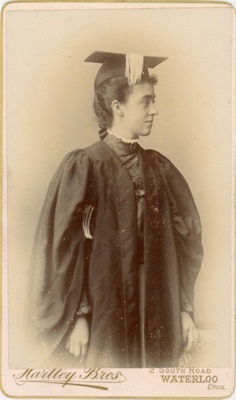Name/TitleCarte de Visite: Unidentified graduate
About this objectCarte de visite of an unidentified young white woman wearing a mortar board and university graduate's cape over a high-necked dress. The photograph is mounted on thick cream card with rounded corners and gold edging. The name and location of the photographer are printed in gold below (partially obscured by the photograph) with more details and a crest on the back.
MakerHartley Bros.
Maker RolePhotographer
Date Madec.1890-1900s
PeriodLate Victorian or Edwardian
Place MadeEngland, Liverpool
Place NotesHartley Bros.
The Studio, 2 south Road, Waterloo Nr Liverpool
Medium and MaterialsOrganic, card
Inscription and MarksOn back:
Top left, in pencil [tiny]: 15
top right, in pencil: 80p
MeasurementsH: 106 x W: 63 mm
Subject and Association Keywordseducation & learning
Subject and Association Descriptionhttps://en.wikipedia.org/wiki/Carte_de_visite:
The carte de visite (French, visiting card), abbreviated CdV, was a type of small photograph which was patented in Paris by photographer André Adolphe Eugène Disdéri in 1854, although first used by Louis Dodero. Each photograph was the size of a visiting card, and such photograph cards were commonly traded among friends and visitors in the 1860s. Albums for the collection and display of cards became a common fixture in Victorian parlors. The immense popularity of these card photographs led to the publication and collection of photographs of prominent persons.
The carte de visite was usually made of an albumen print, which was a thin paper photograph mounted on a thicker paper card. The size of a carte de visite is 54.0 mm (2.125 in) × 89 mm (3.5 in) mounted on a card sized 64 mm (2.5 in) × 100 mm (4 in). In 1854, Disdéri had also patented a method of taking eight separate negatives on a single plate, which reduced production costs. The carte de visite was slow to gain widespread use until 1859, when Disdéri published Emperor Napoleon III's photos in this format. This made the format an overnight success. The new invention was so popular that its usage became known as "cardomania" and spread quickly throughout Europe and then to America and the rest of the world.
By the early 1870s, cartes de visite were supplanted by "cabinet cards", which were also usually albumen prints, but larger, mounted on cardboard backs measuring 110 mm (4.5 in) by 170 mm (6.5 in). Cabinet cards remained popular into the early 20th century, when Kodak introduced the Brownie camera and home snapshot photography became a mass phenomenon.
The carte de visite photograph proved to be a very popular item during the American Civil War. Soldiers, friends and family members would have a means of inexpensively obtaining photographs and sending them to loved ones in small envelopes. Photos of Abraham Lincoln, Ulysses S. Grant, and other celebrities of the era became instant hits in the North. People were not only buying photographs of themselves, but also collecting photographs of celebrities.
https://www.liverpool.ac.uk/womensclub/news/stories/title,995277,en.php:
Eighteen women joined the ranks of the student body in January 1882. Many of them would have been perhaps sixteen years of age; entry at fifteen was permitted for students after tests in a language (Greek, Latin or French), Maths and Science and a recommendation from their recent teachers. Their number had risen to nearly fifty by the late 1880s and stood at 60 in 1892, when the Victoria Building was opened, rising again to 75 in 1896. Students enrolled by term, so the numbers on the roll in any given term could vary considerably. Most of them probably aimed for a qualification at Junior or Intermediate levels of awards in London or Cambridge Local Examinations. The College did not at first offer degrees and when it did it was as a constituent member of Victoria University. An instance of the award of Victoria University degrees can be seen in the Victoria Gallery and Museum with documentation of the academic career of Elizabeth Becket, who took a degree in Greek. The College Magazine gives other examples in 1889 ; BA degrees for Mary Burn and Ellen McConnell and a BSc degree for Jessie Auld. Degrees in Classics, History and Chemistry were awarded in 1890.
Named CollectionGlasgow Women's Library
Object TypePhotograph
Object numberGWL-2022-148-7
Copyright LicenceAll rights reserved


